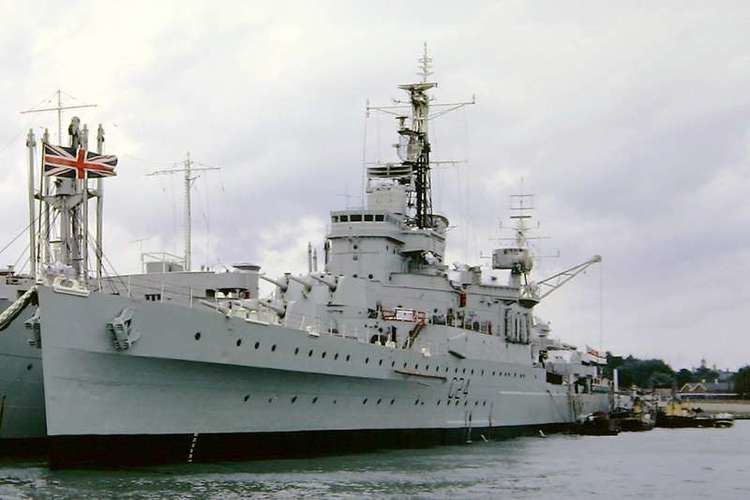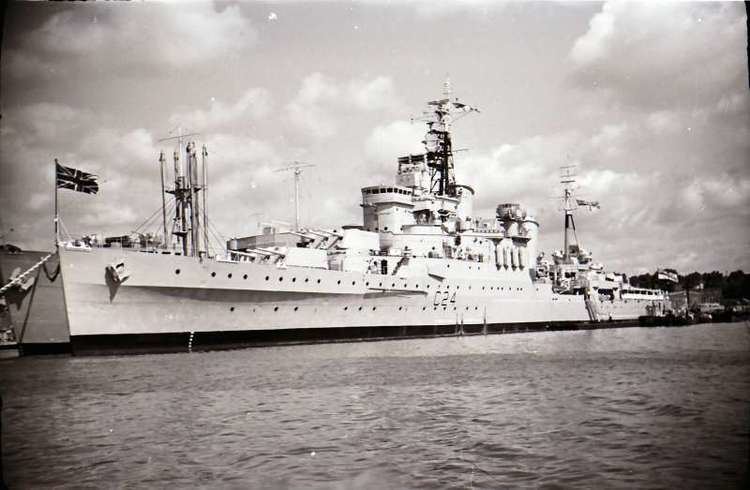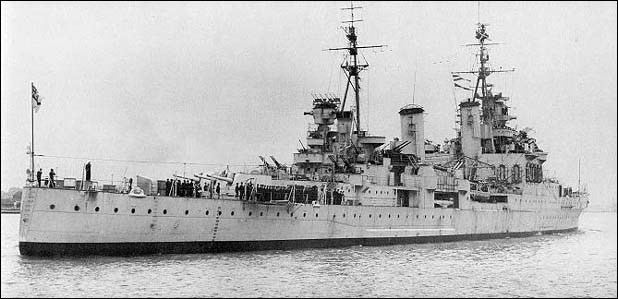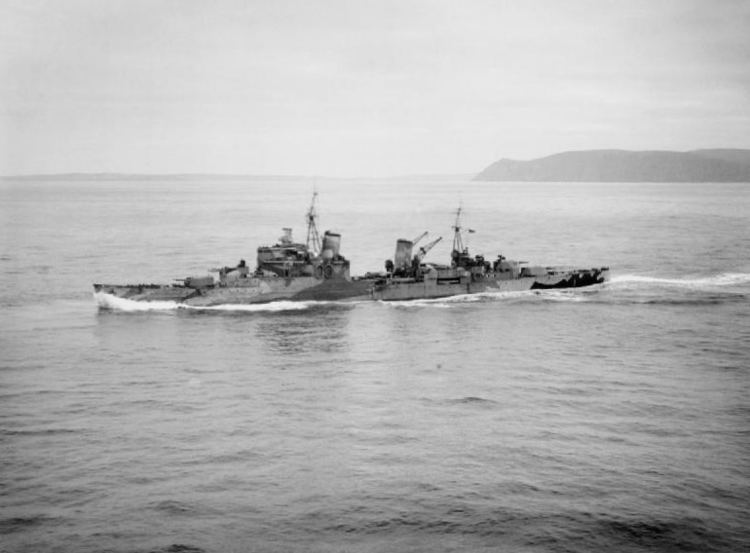Name HMS Sheffield Commissioned 25 August 1937 Nickname(s) Shiny Sheff Launched 23 July 1936 Draft 6.55 m | Laid down 31 January 1935 Construction started 31 January 1935 Length 170 m Beam 19 m | |
 | ||
Fate Scrapped at Faslane, 1967 | ||
HMS Sheffield was one of the Southampton sub class of the Town-class cruisers of the Royal Navy during the Second World War. She took part in actions against several major German warships. Unlike most Royal Navy ships of her time, her fittings were constructed from stainless steel instead of the more traditional brass. This was an attempt to reduce the amount of cleaning required on the part of the crew. Her nickname, the "Shiny Sheff", stemmed from this. A prototype radar system was placed into service in August 1938 on the Sheffield. It was the first vessel in the Royal Navy to be so equipped.
Contents

War service

At the outbreak of war, Sheffield served with the 18th Cruiser Squadron, patrolling the Denmark Straits and then, in April 1940, she was engaged in the Norwegian Campaign. After a short spell carrying out anti-invasion duties in the English Channel, she joined Force H, based in Gibraltar. During that time, she operated in the Mediterranean and the Atlantic until the year's end, and took part in Operation White and the battle of Cape Spartivento.

In 1941, she participated in Operation Grog -the shelling of Genoa, in operations against Vichy convoys and supporting air reinforcements to Malta. In May, Sheffield took part in the sinking of the German battleship Bismarck, narrowly escaping a friendly fire torpedo attack by the aircraft carrier Ark Royal's Fairey Swordfish; Eleven torpedoes were dropped and only defective Duplex exploders and fine ship handling saved her from disaster. (In the report of the attack, Admiral Sir John Tovey, commanding Home Fleet, was told only no hits were scored on Bismarck. The reaction of Sheffield's crew "has not made its way into the official records".) On 12 June, she located and sank one of Bismarck's tankers, Friedrich Breme. After the destruction in early October 1941 of another German supply ship, Kota Penang, (aided by the cruiser Kenya), Sheffield returned to Britain.

She was occupied on Arctic convoys until hitting a mine off Iceland on 3 March 1942 and was under repair until July. After more Arctic convoys, Sheffield joined the forces supporting the Allied landings in North Africa (Operation Torch) in November. In December 1942, Sheffield and Jamaica formed "Force R", under the command of Rear-Admiral Robert Burnett (in Sheffield), which provided cover for Convoy JW 51B. The convoy was attacked by a strong German surface force. In the ensuing action (Battle of the Barents Sea), the Germans withdrew and Sheffield sank the German destroyer Friedrich Eckoldt, while also damaging the cruiser Admiral Hipper, Eckoldt mistaking Sheffield for Hipper. During this engagement, the destroyer Achates and the minesweeper Bramble were sunk by gunfire of the two German vessels.

In February 1943, Sheffield moved to operate in the Bay of Biscay and, in July and August, she supported the landings at Salerno (Operation Avalanche). Returning yet again to the Arctic, she took part in the sinking of the battleship Scharnhorst off the north coast of Norway, in late December.
In 1944, Sheffield was an escort for the Royal Navy carrier force that executed a series of air attacks on the German battleship Tirpitz, between April and August. These had limited success and responsibility was passed to the Royal Air Force.
A lengthy refit in Boston and in Britain kept Sheffield out of action until after the end of the war.
Post-war
The refit was completed in May 1946 and Sheffield alternated between duties in the West Indies (where in 1954 she served as flagship of the 8th Cruiser Squadron) and in home waters and the Mediterranean. From June 1952 to May 1953, her commanding officer was Capt. John Inglis, who was to become director of Naval Intelligence in July 1954. In 1953 she took part in the Fleet Review to celebrate the Coronation of Queen Elizabeth II.
There were further refits in 1949/50 and 1954 and 1959-60. In 1955 she played the part of the cruiser Ajax in the war film The Battle of the River Plate. She went into reserve in January 1959, but after completing the refit of HMS Swiftsure was considered too expensive, HMS Sheffield was the final World War II cruiser to be refitted and became flagship of the Reserve Fleet and served again at sea in 1960 and then as an accommodation ship until September 1964, when she was placed on the disposal list.
Her equipment was removed at Rosyth in 1967 and she was then broken up at Faslane in the same year. The stainless steel ship's bell, which was made by Hadfield's of Sheffield, was preserved and today hangs in Sheffield Cathedral along with her battle ensign.
